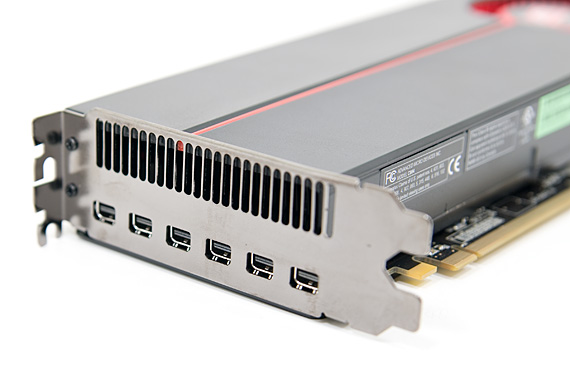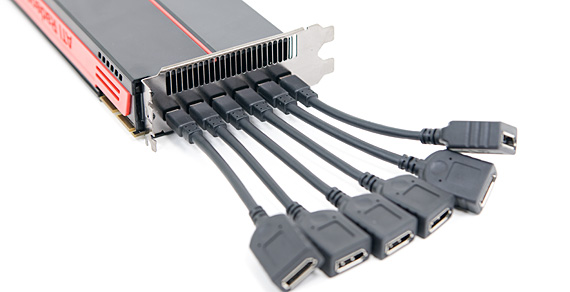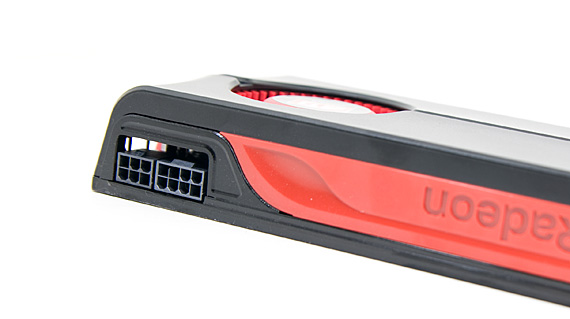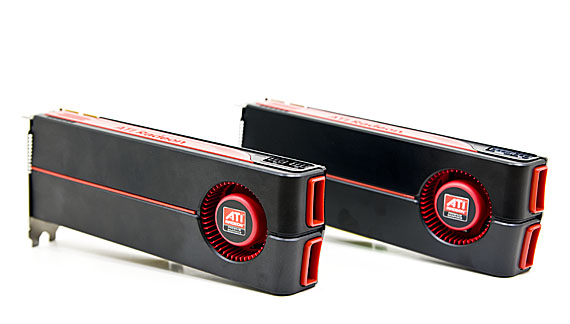AMD's Radeon HD 5870 Eyefinity 6 Edition Reviewed
by Anand Lal Shimpi on March 31, 2010 12:01 AM EST- Posted in
- GPUs
The first time I laid eyes on this card I was visiting AMD's headquarters in Sunnyvale before the Radeon HD 5800 series launch event. I could take photos of the 6 displays it was driving, but not the card itself. So we'll start off with a picture of the things that set the Radeon HD 5870 Eyefinity 6 Edition card apart from its 3-display counterpart.
The most obvious changes are the display outputs. While your standard 5870 has two DL-DVI, one DisplayPort and one HDMI output, the Eyefinity 6 Edition has six mini Display Port connectors.

You can further convert two of those DP outputs into any combination of DVI, HDMI (only one can be HDMI) and VGA. The remaining four connectors must remain Display Port due to the limited number of timing sources on the 5870. The card will come with two mini DP to DP adapters, 2 passive mini DP to SL-DVI dongles and one passive mini DP to HDMI dongle.

Clock speeds have not changed. The GPU still runs at 850MHz core and the memory runs at a 1.2GHz clock speed (4.8GHz data rate). Memory size did change however, the Eyefinity 6 Edition card ships with 2GB of GDDR5 to accommodate the resolutions this thing will be driving. As 256MB GDDR5 is still not available for mass production (and won't be until later this year), AMD is using 16 x 128MB GDDR5 chips in 16-bit mode.
| AMD Radeon HD 5970 | AMD Radeon HD 5870 Eyefinity 6 | AMD Radeon HD 5870 | AMD Radeon HD 5850 | |
| Stream Processors | 2x1600 | 1600 | 1600 | 1440 |
| Texture Units | 2x80 | 80 | 80 | 72 |
| ROPs | 2x32 | 32 | 32 | 32 |
| Core Clock | 725MHz | 850MHz | 850MHz | 725MHz |
| Memory Clock | 1GHz (4GHz data rate) GDDR5 | 1.2GHz (4.8GHz data rate) GDDR5 | 1.2GHz (4.8GHz data rate) GDDR5 | 1GHz (4GHz data rate) GDDR5 |
| Memory Bus Width | 2x256-bit | 256-bit | 256-bit | 256-bit |
| Frame Buffer | 2x1GB | 2GB | 1GB | 1GB |
| Transistor Count | 2x2.15B | 2.15B | 2.15B | 2.15B |
| TDP | 294W | 228W | 188W | 151W |
| Manufacturing Process | TSMC 40nm | TSMC 40nm | TSMC 40nm | TSMC 40nm |
| Price Point | $699 | $479 | $390-420 | $300 |
As a result of the added memory, power consumption has also gone up slightly. The Radeon HD 5870 Eyefinity 6 Edition now requires both a 6-pin and an 8-pin PCIe power connector instead of the two 6-pin connectors of the stock 5870:

The extra memory and five adapters that you get in the box do come at a price. The Radeon HD 5870 E6 Edition is expected to retail for $479. That's $100 more than the MSRP of the 5870 but only $59 more than its actual street price. It remains to be seen what the street price of the 5870 E6 will end up being given that TSMC 40nm production is still limited with improved but not yet perfect yields. These cards should be available immediately.
Update 4/1/2010: Launch prices appear to have missed their target. We're seeing the 5870E6 sold out at $499, and in-stock elsewhere at $549. This puts it at an $80 premium over the reference 1GB 5870.











78 Comments
View All Comments
cfaalm - Wednesday, March 31, 2010 - link
Why don't AMD go talk to display manufactureres to thin out or even totally forego any bezels on Eyefinity compatible displays? In other dual/multiple screen situations than Eyefinity it can still be desirable to have real thin or no bezels, so it won't be that far out.Aclough - Wednesday, March 31, 2010 - link
They're working on them now, but they aren't out yet. Be warned that they'll probably cost more than normal monitors though.cfaalm - Wednesday, March 31, 2010 - link
I expected they would cost a bit more. Though I don't have any figures on the premium I guess it would be worth it compared to what gains can be had it these special situations where you'd be spending a small fortune anyway.mjrpes3 - Wednesday, March 31, 2010 - link
It's greatly in their interest to develop this technology: lowering the barrier and increasing the incentive to buy 3x or 6x quantity of a product.Calin - Thursday, April 1, 2010 - link
Sell more cheap monitors instead of fewer expensive monitors? I don't think so.Calin - Thursday, April 1, 2010 - link
The bezels are there with a purpose (strength, if nothing else).There are monitors with thin bezels - what we might need now could be pre-built monitors in 6x configuration, reducing as much as possible the bezel size (they could do it better in the factory). Maybe some boutique industry could spring from this? Something like the tuning shops in the auto industry
behrouz - Wednesday, March 31, 2010 - link
Hi Anand.this is very beautiful and the logo at top of page is better than previous logo.
good luck.
Manuel1975 - Wednesday, March 31, 2010 - link
Does anybody know if there will be any mac drivers? This would be a formidable beast in combination with MacPro and Mediaserver Software...erple2 - Friday, April 2, 2010 - link
I think that this tech would be wasted on a Media Server implementation. Unless you're talking about something different than what I'm thinking of. Streaming media to these devices would be essentially pointless, as few, if any, media is available at any resolution beyond 1080p.Putting it on a Mac makes even less sense, given that what makes this unique is the ability to run solid 3D games titles. And last I checked, there were few, if any, 3D games available on the Mac Platform.
While Apple does offer multiple graphics cards in their MacPro systems, they're generally very low-end graphics products (currently NVidia GeForce GT 120 based), meant to drive CAD or other non-3D gaming applications. Those can easily handle any Media server load you could throw at it. I suppose you could make the argument that it could upscale the video to 2160p (doubling 1080p), but that seems to be pointless to me - just run a larger 1080p projector.
Manuel1975 - Tuesday, August 3, 2010 - link
Hi Erple,The media I use to drive multiple dipslays normaly reqiure something along the range of 640x480 to a 4k type of resolution. Although these high resolutions are not mainstream, Youtube for instance does alow you to upload videos in 4k resolution. The future of HD+ video is very very near.
And nowadays OSX ships with something called quartz composer. This something you can compare with prosessing. Its OpenGL bases image synthesis. Truely amazing stuf: 4k+ resolutions rendered at 60hz. Eazely.
Tip for your next post: try to think outside your box before posting.